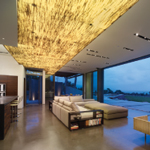If a building’s already built, making alterations and renovations can sometimes feel architecturally limiting. However, Vermont-based designer Milford Cushman, principal and owner of Cushman Design Group, says he finds a certain freedom in the process, and his affinity for such projects is perhaps best represented by his recent refurbishment of Haven, a century-old, 2,356-square-foot fishing cabin situated on Caspian Lake in Greensboro, Vermont. Built in the days before modern building codes, Haven possesses a special connectedness with its surrounding environment, and Cushman’s delicate renovation retained the dwelling’s embrace of the natural while incorporating a measure of modern, behind-the-scenes functionality. Here’s a look at how it got done.

1. Understand the original
Haven was originally constructed in 1910 as a summer cabin, or “camp” as it is referred to in the Northeast, and was used primarily for rest and outdoor activities. The original camp was made entirely of wood, without sheetrock or insulation protecting the interior from the elements. “This was really a summer residence,” Cushman says. “Over the years, some wings had been added on the home, but we removed these wings because they weren’t built to the same quality as the original camp, and doing this helped the new owner achieve her programmatic requests.”
2. Incorporate code restrictions
“Today, a home of this sort wouldn’t be able to be built so close to a lake,” Cushman says. “The permitting of this project was a foot-dance between wanting to preserve the quality of the original building while working within the square footage of the original footprint.” Thus, while redesigning Haven, Cushman allowed only the alterations to its footprint that were necessary to correct the interior program of the house, enabling him to fit in a series of new rooms and systems.
3. Redraw the program
Renovation of Haven began in December 2011 and was concluded in July 2012, with Donald P. Blake Jr. Inc. serving as general contractor for the duration of the project. Cushman has worked with a number of building contractors on his different projects, including also Steve Sisler with Sisler Builders, who conducted construction for another Cushman project: the Home 4 All Seasons.
Haven abides by its original camp style, with a basic two-story design and a porch on the lower level. The upstairs formerly comprised three bedrooms, and Cushman was able to add a new bathroom and a family room. He also put in a new kitchen and mudroom wings on the lower floor, below the new family room.




4. Modernize the structure
“The only building that can be built in Vermont that does not need to meet the energy code is a hunting camp,” Cushman says. “Haven is not a hunting camp; it’s a three-season camp, so it needed to meet the energy code.” The camp is now fully insulated, uses double-pane windows, and includes highly efficient building technologies. The only season it’s not equipped for is winter.
5. Insert a mechanical pit
“There were no mechanical systems whatsoever when we began our work,” Cushman says. As part of Haven’s modernization, Cushman included a pit—accessible from above through the home’s mudroom—to house the cabin’s mechanical systems, including a high-efficiency boiler and equipment for propane gas. The walls of the pit are composed of insulated concrete forms (ICFs) that prevent outside temperature fluctuations from harming the gear.
6. Maintain septic-field integrity
 “The septic-system site is sacred for Haven,” Cushman says, explaining that Haven’s precode construction located the sewage-treatment apparatus close to the lake. “The septic site couldn’t be tread on by machinery or equipment of any kind. A replacement system for this type of building would now need to be a system of holding tanks, and that’s not ideal for anyone.” The extant septic system was grandfathered in, and the new layout was designed to accommodate it.
“The septic-system site is sacred for Haven,” Cushman says, explaining that Haven’s precode construction located the sewage-treatment apparatus close to the lake. “The septic site couldn’t be tread on by machinery or equipment of any kind. A replacement system for this type of building would now need to be a system of holding tanks, and that’s not ideal for anyone.” The extant septic system was grandfathered in, and the new layout was designed to accommodate it.
7. Admire the finishing touches
“Everyone involved in this project knew they weren’t just going into a neighborhood to build an ordinary house,” Cushman says. “Haven has a lot of special qualities that make the camp completely unique.” In particular, the home’s unusual proximity to the water and its salvaged Vermont-style camp aesthetic give Cushman reason to take special pride in his renovation and modernization of the generational piece of real estate.





